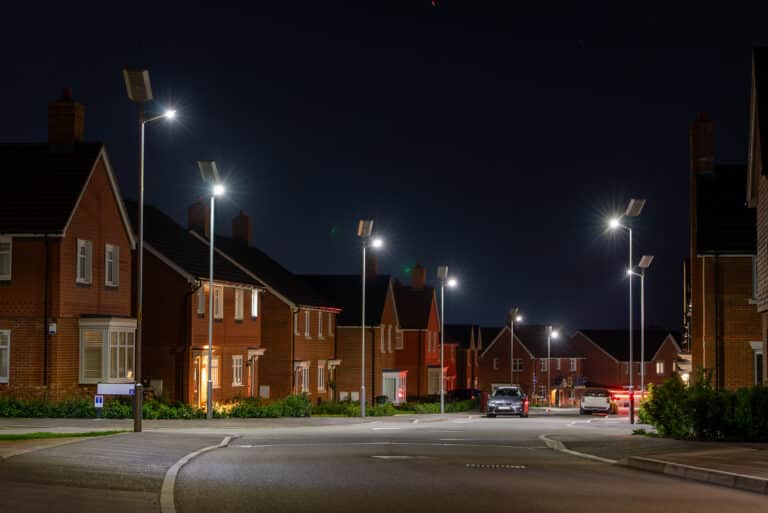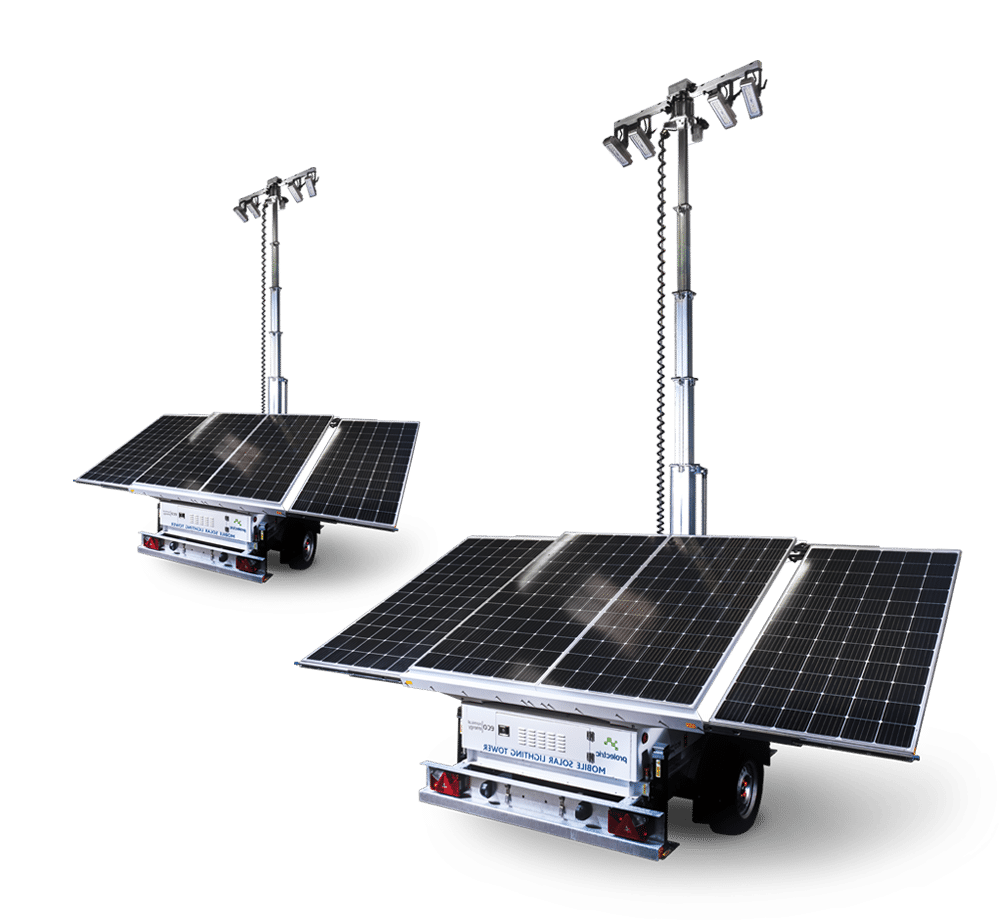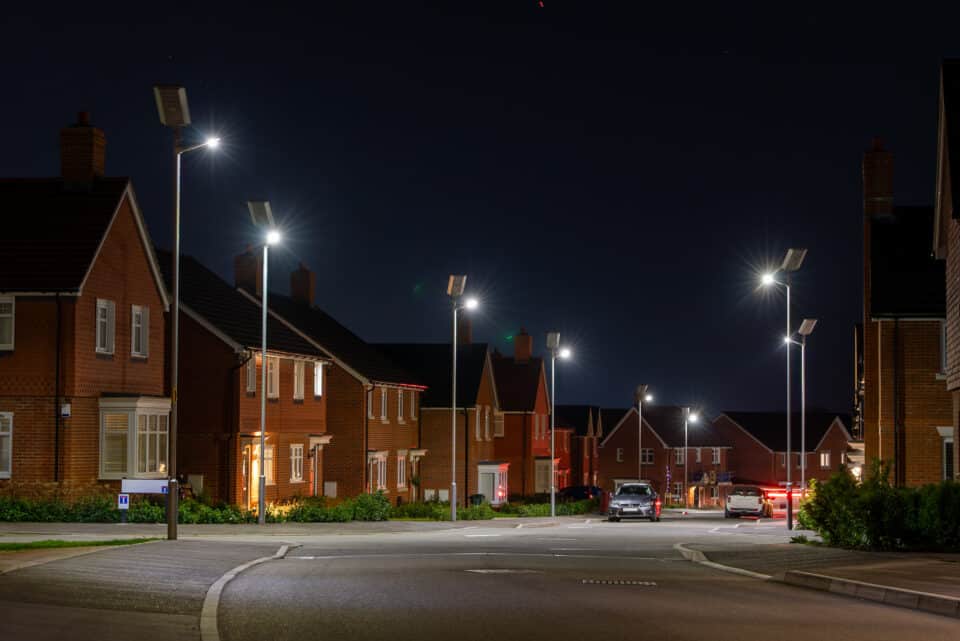
Private and public exterior lighting in the UK is a massive contributor to the country’s total carbon emissions. Included in these emissions are over seven million public street lights, each of which uses a significant amount of electricity depending on the exact type of lantern. According to a State of the Nation report on street lighting, annual running costs could reach £379m by 2030.
It is not just about running costs and the carbon associated with generating electricity. There is also the matter of embodied carbon – the carbon that is released during the works for the manufacture, installation and removal of the lights.
Installing exterior lighting running on trenched mains power is an expensive and disruptive proposition, both for new and existing public or private estates. However, lighting is an essential part of any estate, whether it is commercial or public. Well-lit areas are safer and more welcoming, both in terms of accidents and crimes (according to a study by the College of Policing).
Over the past decade, there has been a concerted push towards the use of efficient LED lanterns in new lighting and in upgrading existing lights. It is estimated that simply converting the remaining non-LED street lights to LED would save £125m per year by 2030.
However, exterior lighting technology has moved on from simply using the same paradigm with more efficient LED lanterns.
Today it is possible to take mains power out of the equation, running permanent exterior lighting with solar power alone. Lights do not need to be linked, meaning that the time, cost and carbon of digging trenches is eliminated. Lighting can be installed quickly, with zero ongoing carbon emissions and zero ongoing maintenance.
There is sometimes a perception that sustainable power technology is an area that is still evolving and that the time is not yet right to invest. However, this is outdated when it comes to solar, which is now a mature technology.
“We were the first to introduce solar-only permanent street lights to the UK in 2011,” says Rachel Preen, MD at Prolectric, the market leader in solar lighting for streets, car parks and footpaths. “We have thousands of units installed nationally, proving to work all night long, all year round, even in the depths of the British winter.”
Facing the challenge of embodied carbon
Embodied carbon, refers to the total greenhouse gas emissions associated with the entire life cycle of a building or estate. It means considering every aspect, including:
- Resource extraction, such as the mining required to provide the basic materials.
- Manufacturing processes, where the raw materials are turned into those elements used in the estate’s construction, from bricks and mortar, to permanent exterior lighting.
- Transportation in every aspect and stage of the building process.
- Installation and construction, including preparatory excavation works and so on.
- Any ongoing maintenance, replacement or removal.
Embodied carbon matters because it is a hidden but significant contributor to climate change. Often, we only consider the emissions a product creates while we use it, such as electricity usage in the case of exterior lighting (also known as operational carbon).
Replacing existing external lighting with solar lighting is an effective way to reduce embodied carbon emissions on large commercial properties and public estates. The Prolectric AE6 Solar LED Street Light, for instance, can even be retrofitted to existing lamp posts to provide power-free, maintenance-free lighting.
Even when replacing lamp posts, permanent solar lighting involves less embodied and operational carbon. There are no trenches to dig or cabling to lay, the lights are fully independent and need no external power to operate. Operational carbon emissions are zero, thanks to being fully powered by solar. There is no maintenance required, while components that come to the end of their life can be swapped out without changing the whole unit, again helping to reduce embodied carbon.
If you are responsible for Estates and Facilities Management, whether that is in the private or public sector, exterior lighting is an easy way to make significant progress in decarbonising your estate.
Reducing the cost of external lighting
Saving money through permanent solar external lighting and reducing your carbon emissions goes hand in hand.
Taking a real-life example, the Prolectric AE3 and AE6 Solar LED Street Lights are high-quality, year-round, solar-powered LED systems. Replacing existing exterior lighting with one of these systems, or choosing one of them to light a new commercial or public estate, offers significant cost savings in several areas:
- No ongoing electricity costs. No mains energy or grid connection is required, which also means that the lighting will continue to work even in a power cut.
- No cabling or trenches to dig during installation. The lights do not need to be connected, so no contractors are required for cabling and no machinery is needed to dig trenches. Typically this means that installation costs are halved compared to connected street lights.
- Fast installation, which means less disruption to roads and traffic.
- Fewer contractors onsite for a shorter time, which is particularly important for estates that are security sensitive.
- No maintenance required. When an element in the street light comes to the end of its operational life, a new part can easily be swapped in.
- No blackouts – In the event of a power cut, the lights stay on, providing reassurance to those in the vicinity.
- Reduced pressure on the grid, which is having increasing demands placed on it due to the need for EV charging.
Proven to work in the UK, all year round
The process of decarbonising internal lighting is reassuringly straightforward – you replace everything with the most efficient LEDs you can find and power them with a green tariff from your electricity provider.
Exterior lighting is a trickier problem to solve but the rewards are enormous in terms of both carbon and cost savings. What’s more, the fact that they are situated outside means that high-quality solar solutions can do away with the need for a mains connection completely.
We have been making and installing permanent solar lighting solutions for over 10 years. We are the market-leader in solar-only permanent street lights, with customers including national housebuilders, Ministry of Defence bases, local authorities and main infrastructure contractors. Applications include street lighting, parks and recreation areas, public areas, bus stops and shelters, car parks and perimeters, marinas and harbours, and footpaths. Our engineers also have the expertise to advise on lighting layout and report on the lux levels in line with British standards, across an estate.
From day one, we focused on refining our products to ensure they work perfectly in UK conditions, even during winter on cloudy days. The Prolectric AE6 and AE3 Solar LED Street Lights are our state-of-the-art exterior lighting solutions:
- The AE3 is a medium to high power solar street light integrating all components such as lamp, battery and solar panel together for a zero-maintenance experience. It can produce an output of up to 1,800 lumens.
- The AE6 is the brightest and most powerful solar light, providing outstanding performance. It can produce an output of up to 4,000 lumens. It can also be easily retrofitted on to an existing lamp post, reducing embodied carbon and installation costs.
Both the Prolectric AE3 and AE6 Solar LED Street Lights come with a raft of technical innovations that ensure reliable operation throughout the UK winter:
- New-generation lightweight lithium LiFePO4 batteries deliver high power and longevity.
- Each light has an integrated charging unit that constantly monitors the state of the battery’s charging circuit to optimise power levels and ensure maximum efficiency.
- Self-dimming technology ensures that minimum lighting levels are still achieved when battery charge is at its lowest.
- A unique proprietary motion detection system uses three passive infrared sensors to detect motion at a wider range, ensuring the light switches to full brightness to illuminate an area when populated.
Conclusion
The transformative potential of solar-powered exterior lighting for decarbonising estates is clear. Traditional street lighting is simply too expensive, in terms of both energy and installation costs and embodied carbon from installation and maintenance.
Permanent solar lighting is a mature technology and our solutions have been proven in the field for over a decade to deliver reliable lighting, even in the UK winter. They are fast and easy to install and eliminate the need for costly cabling and groundworks, making them ideal for both new builds and established estates. Both Prolectric AE3 and AE6 can even be retrofitted to a suitable existing lamp post, making installation on an existing estate even quicker. Importantly, solar lighting puts an end to reliance on mains power, functioning reliably on solar energy and generating zero operational carbon emissions.
The benefits extend far beyond environmental impact. Solar lighting unlocks significant financial savings through eliminated electricity bills and reduced maintenance requirements. It is a genuine win-win scenario, simultaneously reducing the environmental impact of your exterior lighting and lowering your ongoing costs.
Across both public and private sectors, switching to permanent solar solutions for exterior lighting on estates and large commercial properties can help you shape a more sustainable future and deliver on your decarbonisation goals with minimum effort.







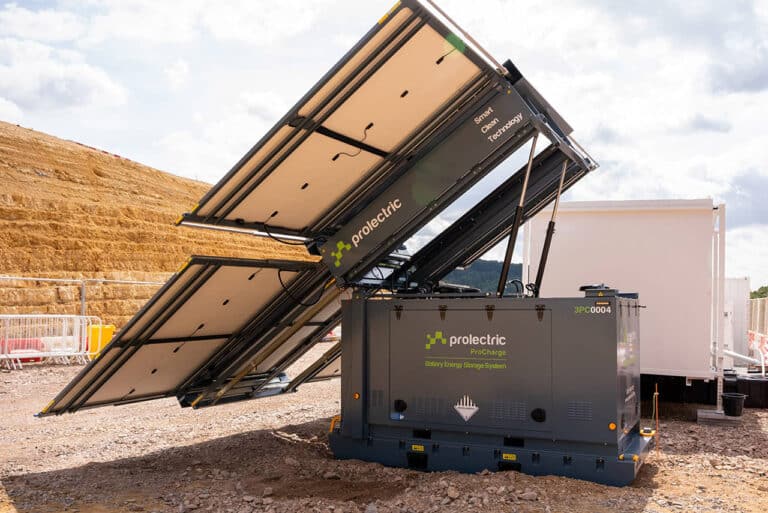


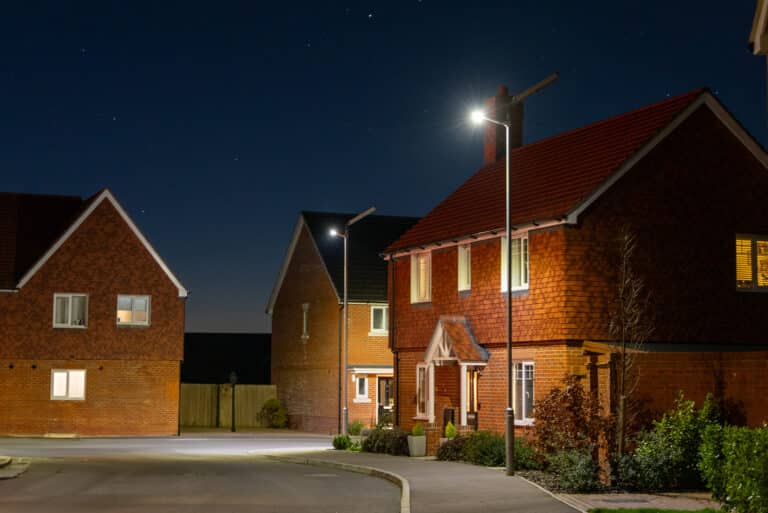


![Prolectric ProPower Water Utilities [Day]](https://media.prolectric.co.uk/uploads/2024/04/Pro-Power-Water-Utilities-Day-768x512.jpg)
